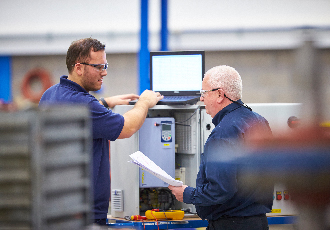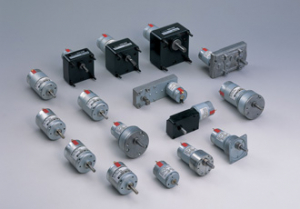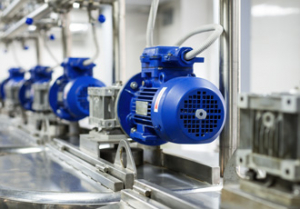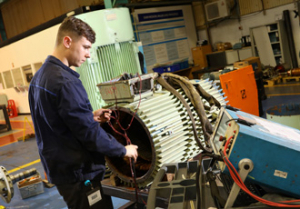Looking after variable speed drives reduces down-time

The legislation around the efficiency of electric motors is continuing to tighten, and therefore the volume of Variable Speed Drives (VSDs) in service increases. Often specified by the motor manufacturer as part of the original installation - or retrofitted to improve efficiency - the drive contains both hardware and software that is designed to work with a motor in a specific application. So, what happens if the drive ceases to operate?
To answer these questions, Brian Park, Regional Sales Manager for Scotland at Sulzer, looks at the advancing technology and the maintenance processes that need to keep pace.
Inverters, Variable Frequency Drives (VFD) and VSDs are all effectively achieving the same goal, to control the speed and torque of an AC motor by varying the frequency and voltage of the motor supply. In modern applications they can interpret a range of input signals and vary the motor output according to the predefined software that is installed. In this way drives are capable of making significant energy savings by matching the motor output to the demands of the process.
The increased implementation of drives has also been fuelled by the latest European energy efficiency regulations for electric motors that came into force in January 2015. Under Regulation 640/2009, any new installation using a motor between 7.5-375kW must use either an IE3 rated motor or an IE2 motor installed with a VFD. Furthermore, in 2017 this will be extended to include all motors rated between 0.75-7.5kW.
However, the technology has been around for decades and over the years the size of drives has drastically reduced, while the control features have become more numerous and the overall energy savings have increased. This advancement also means that a great deal of the original equipment is now obsolete, therefore if any problems do develop, finding a suitable repair may prove difficult. Some might advise complete replacement, but this may not be the most cost effective solution, especially on larger pieces of equipment.
Avoiding down-time
Most industrial processes will have a period of time set aside for maintenance; it may be a specific shut-down period or it may be a regular programme that looks at individual items in a manner that suits the on-site maintenance department. However, very often these maintenance schedules will look at the mechanical items, such as motors, pumps, fans, bearings, chains, belts and so on, but will neglect to carry out any checks on the electrical side.
Periodic electrical inspections may be carried out on the wiring installation, but unless specifically identified, items such as drives would be omitted from such an inspection. Very often VSDs are viewed as ‘black box’ technology and so only warrant attention when something goes wrong. Unfortunately, this approach can lead to considerable down-time, which may have a significant effect on overall production.
Many industrial and commercial companies are taking a more pro-active approach to maintenance but often this is not applied to electrical equipment such as VSDs. In many cases the in-house maintenance department may not contain the required skills or equipment and so it would be better to employ the services of a specialist, rather than overlooking the issues.
Engaging the services of an experienced repairer can pay significant dividends, not only for the preventative maintenance inspections, but also for repairs and general product support, which can minimise down-time in the event of a failure.
Periodic inspections involve analysing error codes as well as inspecting electrolytic capacitors, Printed Circuit Boards (PCBs), carrying out insulation resistance tests, fan and ventilation checks and using thermography to identify any loose connections or overheating components. In addition, the control program should be checked and also saved to an external location allowing it to be reloaded onto a new drive in the event of a catastrophic failure.
On-site diagnosis to determine the cause
In situations where a drive has failed, on-site diagnosis is crucial in order to determine the cause of the failure and to assess to most effective solution. Often the customer, and more specifically the operator, can provide vital information that can be used in conjunction with the error code information to establish the root cause of the failure. A thorough assessment will determine if the repair can be made on-site or if the drive needs to be taken back to the service centre.
In many cases the control side will be operational; it is usually the power side that fails, as this has to perform the majority of the work. However, it is essential that all of the components, such as the diodes, capacitors and Insulated Gate Bipolar Transistors (IGBT), which form the heart of the speed control features within a VFD, are in full working order.
In addition, it is important to check the attached equipment as well, in case there is a cable or a winding fault that has caused an issue within the drive. These checks include verification of the control software to ensure that it is still meeting the application requirements. In some cases improvements can be made to the software that will improve performance and efficiency, delivering further benefits to the customer.
Regular maintenance of VSDs, while the drive is still operational, is important. Not only does it highlight any issues to the customer, it may also offer solutions that can be implemented at a time best-suited to the customer; rather than forcing a reactive response in the event of a breakdown. With over 20 years’ experience in the repair of electronic drive control units, Sulzer service centres can provide a cost effective package that offers both preventative measures and a complete repair service that complements Sulzer’s wider maintenance offering.
Similar articles
More from Sulzer Ltd
- Construction of Sulzer’s new Birmingham Service Centre on track 8th September 2020
- Electrical distribution powered up for holiday period 1st July 2020
- Rapid reverse engineering 18th December 2019
- The future of the oil and gas sector is now 25th October 2019












Write a comment
No comments